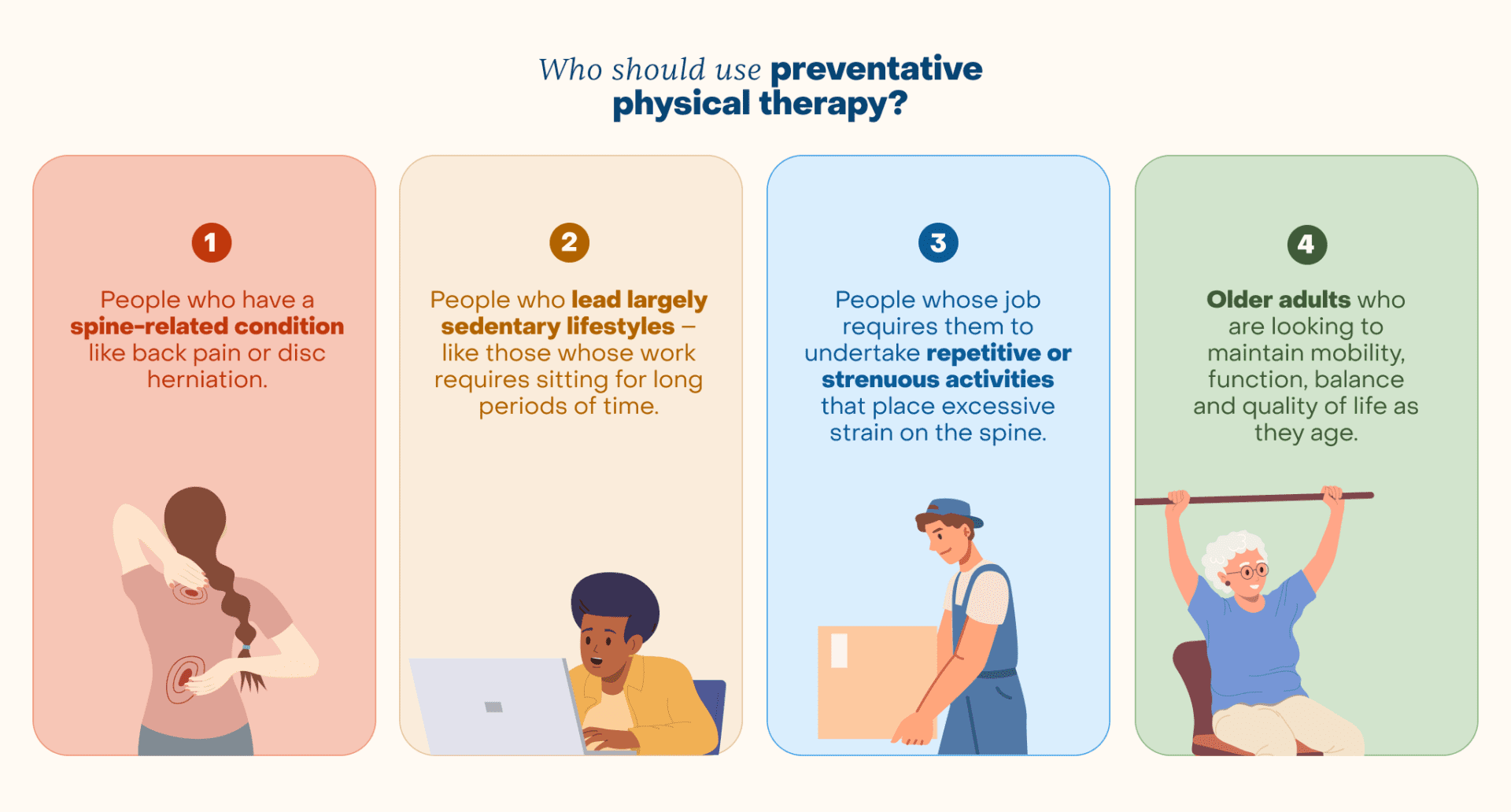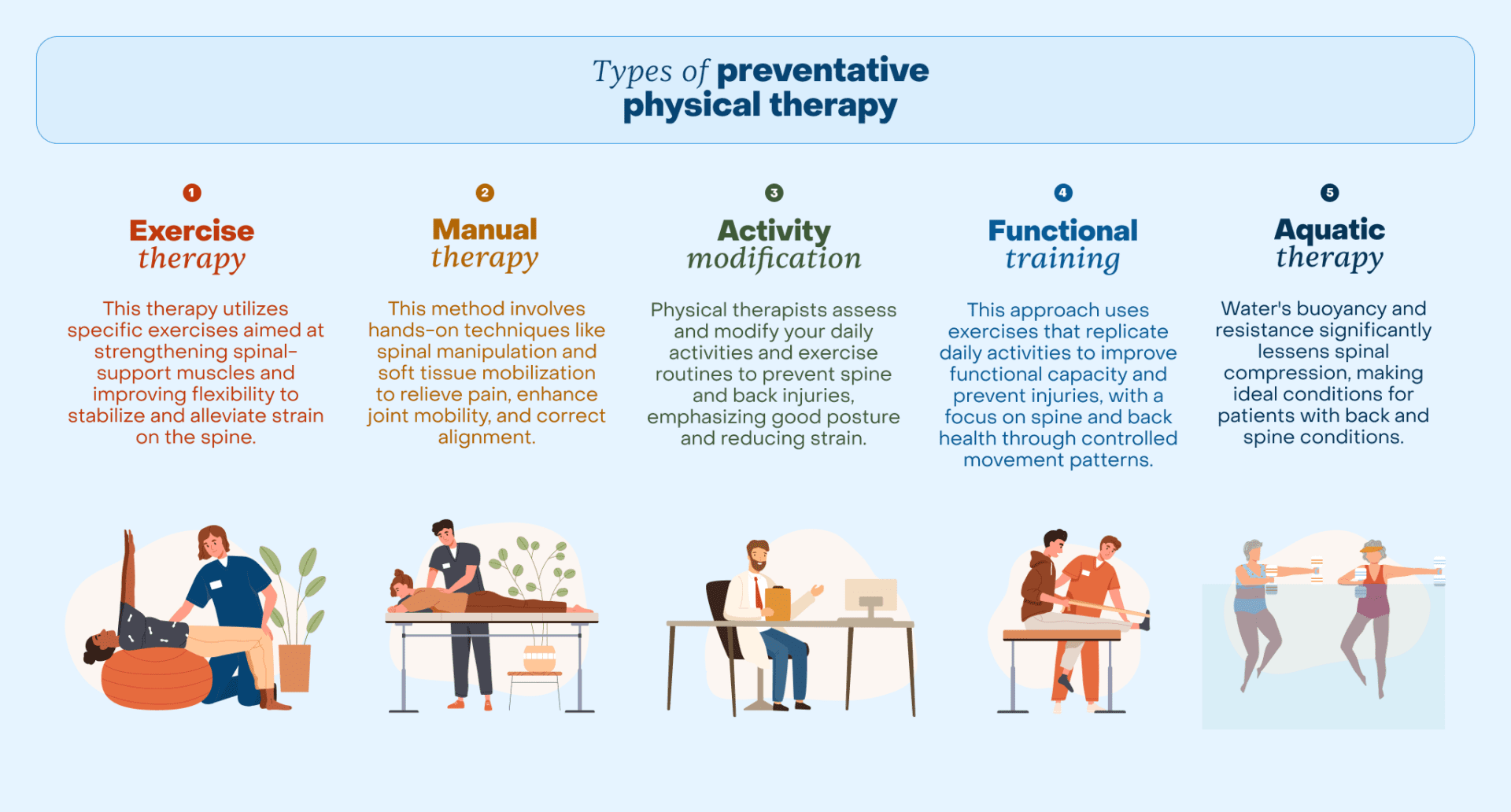Most people think of physical therapy exclusively as a treatment for pain or injury. But there has been a significant shift in spinal healthcare toward injury prevention, especially when it comes to the back.
The human spine is a complex arrangement of bones, discs, muscles, ligaments and nerves. These work together to provide stability for your body and facilitate movement. But the spine can be vulnerable to degenerative conditions, injuries and postural abnormalities, which can lead to pain and functional limitations.
Preventative physical therapy is a proactive way to maintain the health and functionality of your low back, neck, and the entire spine. The goal of preventative physical therapy is to address potential issues before they escalate into more serious conditions and to develop a personalized home exercise program that can be maintained over time.
Physical therapists also equip people with the knowledge and skills necessary to maintain spinal health throughout their lifespan. With this type of education, we are more likely to understand the importance of what we learn and are more likely to prioritize preventative measures.
Approximately four out of five people will experience low back pain during their lives, and it is one of the most common reasons for healthcare visits in the United States. Despite the fact that low back pain can be extremely painful and incapacitating, most cases are temporary and don’t require surgery. If you’re experiencing mild back pain or you are at risk for a spinal condition, consider preventative physical therapy.

What is preventative physical therapy?
Physical therapy is a discipline of licensed healthcare professionals who work with people who have sustained injuries, disabilities, impairments, or limitations in their overall physical function. Some of the benefits of physical therapy include reduced pain and inflammation, and improved mobility, strength, alignment, and balance.
Physical therapists can work preventatively with individuals who may display only mild pain or are at risk for spinal conditions by managing inflammation and pain, and improving mobility. Preventative physical therapy uses a combination of targeted exercises to strengthen a patient’s core, back and other muscles, improve their posture, and help them adopt healthy movement patterns.Physical therapy can be very effective in improving balance, reducing falls, and controlling symptoms related to osteoarthritis and spinal conditions. Osteopenia and osteoporosis are most commonly asymptomatic until late in the disease state, but physical therapy can be used to design a program focused on weight-bearing exercises that promote bone health.

What does the research say about preventative physical therapy?
Research studies have consistently demonstrated the effectiveness of preventative physical therapy in reducing the incidence of low back pain and improving functional outcomes.
A 2018 study reviewed the literature on prevention and treatment of low back pain. Although physical therapy is commonly thought of as a treatment for low back pain, it was also found to be beneficial in the prevention category, where it was recommended that healthcare professionals regularly deliver education surrounding back pain and promote physical therapy and exercise.And a 2018 study found that people with a new diagnosis of back pain who saw a physical therapist early had a lower probability of having an opioid prescription and significantly lower out‐of‐pocket costs than those who saw a physical therapist later or never.

Who should use preventative physical therapy?
If you suffered from an episode of any spine-related conditions like back pain or disc herniation in the past, you may benefit from preventative physical therapy to reduce the risk of recurrence. Additionally, if you have a family history of osteoporosis, preventative physical therapy is an important measure to start a bone-strengthening program now.
People who lead sedentary lifestyles – like those whose work requires sitting for long periods of time – can develop muscle weakness, joint stiffness and poor posture. All of these can increase the risk of spine and back problems. Preventative physical therapy can help you implement strategies to counteract the negative effects of sedentary behavior and promote healthier habits.
Conversely, if your job requires you to repeatedly undertake repetitive or strenuous activities that place excessive strain on the spine – like heavy lifting or bending – you should consider preventative physical therapy to strengthen your back muscles and reduce the risk of overuse injuries.
Finally, aging is associated with natural changes in and around the spine, like decreased bone density, muscle mass, and flexibility. Preventative physical therapy can help older adults maintain mobility, function, balance and quality of life.

Types of preventative physical therapy
Physical therapists use a variety of modalities to strengthen the spine and surrounding muscles in order to give clients the best quality of life possible. These include therapeutic exercise, manual therapy, functional training and more.

1. Exercise therapy
Exercise therapy involves specific exercises designed to strengthen the muscles supporting the spine. These include core strengthening exercises that help with spinal stability, and flexibility exercises – stretching tight muscles to reduce strain on the spine.
2. Manual therapy
Manual therapy involves hands-on manipulation and mobilization of the spine and surrounding tissues to alleviate pain, improve joint mobility and restore proper alignment. Common manual therapy techniques used in preventative physical therapy include:
- Spinal manipulation: High-velocity, low-amplitude thrusts applied to specific spinal segments to restore joint mobility and alleviate pain.
- Soft tissue mobilization: Techniques such as massage, myofascial release, and trigger point therapy to address muscle tightness and dysfunction.
3. Activity modification
A physical therapist can help by discovering small issues that could lead to chronic problems down the road. Physical therapists can assess your activities and lifestyle habits to identify potential risk factors for spine and back injuries, like muscle imbalances, muscle weakness or overuse of muscles.
They’ll recommend modifications to daily activities or exercise routines to reduce excessive strain on the spine. They may also provide guidance on maintaining good posture during daily activities.
4. Functional training
Functional training involves exercises and movement patterns that mimic activities of daily living to improve overall functional capacity and reduce the risk of injury. Physical therapists may prescribe functional exercises tailored to an individual’s specific needs and goals, focusing on activities such as bending, twisting, lifting, and reaching in a controlled manner to promote spine and back health.
5. Aquatic therapy
Aquatic therapy uses the buoyancy and resistance of water to provide a low-impact environment for rehabilitation and exercise. Water-based exercises can be particularly helpful for people with spine and back issues since water reduces the compressive forces on the spine during movement.
Does insurance cover preventative physical therapy?
Every insurance policy treats physical therapy coverage differently. The extent of coverage, copayments, and deductibles may differ between plans. Some insurance carriers may handle preventative physical therapy differently, and some may not. You may find that your plan covers training sessions with either a physical therapist or an athletic trainer who often works alongside a physical therapist.
To find out what you qualify for, talk to both your insurance company and the physical therapy center you plan to use. They can give you more information on whether or not you need a referral, if pre authorization is required, how many visits they cover, if you’ve met your deductible, and what your contribution in copayments might add up to.
Conclusion
Preventative physical therapy represents a paradigm shift in the management of spine health. Proactive strategies can preserve the strength, flexibility and function of your back, neck and spine, and lower the risk of spine-related symptoms.
By ensuring that your spine remains as strong and resilient as possible, preventative physical therapy can be an important investment in your long-term well-being.
Every body is different, and every body requires its own unique treatment plan. Ask your doctor about preventative physical therapy for your spine health.



